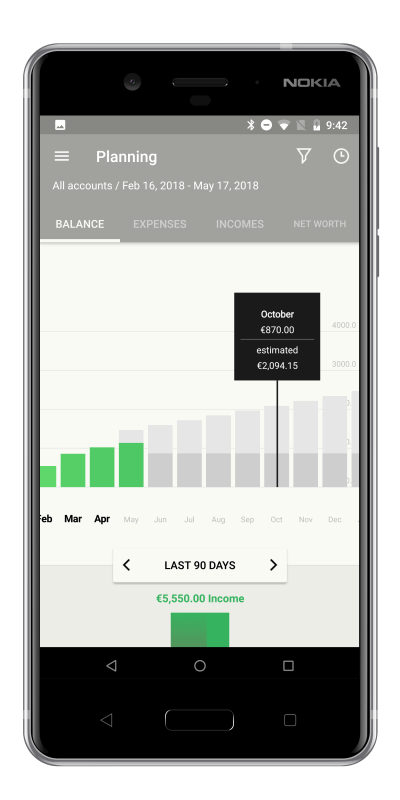Learn from your past spending and earning patterns and prepare for the future. That’s what the Planning graphs are all about.
Switch between 4 tabs to monitor all main aspects of your personal finance:
- Balance
- Expenses
- Incomes
- Net Worth
and make use of detailed views, calculated averages and estimates for the future. Filter the display of your financial data by category, tag, account or location, and compare the incomes with expenses and budgets in the River flow graph.
This feature is available with Toshl Pro or Toshl Medici subscriptions.
Balance – monthly balance of incomes and expenses
This balance is shown separately for every month and is calculated as:
monthly incomes – monthly expenses = monthly balance
Staying in the positive, above the central line, is crucial. It might evade you sometime, but aim for it on a yearly average.
Expenses – spending per month
This section shows you the sum of expenses for each month, but can also be filtered to display spending for chosen categories, tags, locations and financial accounts.
Incomes – earnings per month
Display of the total sum of incomes each month can be further adjusted by filtering by categories, tags and financial accounts.
Net worth – total balance of your financial accounts
These funds accumulate if you have regular surpluses on your monthly balances. The amounts reflect the account balances at the end of the month.
Tap & hold for details and a lollipop
To get the exact value for each column, tap and hold somewhere on the graph.
A “lollipop” will pop up, displaying the exact value for that particular month.
Past months will also display averages for the last 12 months, while future months show the estimates for the chosen period.
River flow – see the financial flows each month
You’ll notice that the River flow graph is displayed below the multi-month graph. It shows how your incomes and expenses compare to each other and your budget in an individual month. If you have a monthly budget for all expenses, River flow will include it in the calculation as well. That way you’ll always know how much you can spend while staying within your budget limits.
Travel in time
12 months are shown on the graph – by default 6 past ones, the current month, as well as 5 future months.
You can move through time by using the < > arrows under the graph, swipping left or right, or by using the general time span settings from the right sidebar.
If you’re interested in sums for a certain period, you can also select a custom time span. The selected months will be displayed in darker color below the graph and you’ll see sums for the entire period.
Filter by category, tag, account, location
You can zero-in on specific data you’re interested in and want to see over a longer period of time.
Let’s say you want to know how your spending on Food & Drinks varies in time. Tap on the Filter icon in the upper right corner, select “Expense categories” from the menu, then tap “SELECT” and choose “Food & Drinks”. Return to the graph by tapping the “back” arrow in the upper left corner. Your spending data is now filtered to only display the expenses for the Food & Drinks category, so you can see how it varies through the year.
You can narrow it down even further by selecting a tag. Do the same in the “Expense tags” section and you can see how much you spent only on restaurants, alcohol, groceries, or a combination of multiple tags.
You don’t have to pick only one filter. They can be combined. For example, you can set it to only show expenses paid with MasterCard (financial account), for Leisure (category), for books, movies and music (tags), in HMV Manchester Arndale (location).
The filtering is global, so it will work with all the data in your Toshl app. Any filter that’s applied will be displayed above the graph, and the excluded categories, tags, etc., will be written in strikethrough.
Estimates and planned expenses
You’ll notice that the future months on the graph aren’t as colorful. That doesn’t mean that the future isn’t bright, just a bit hazy for now.
The semi-transparent columns in future months can display your planned entries, future estimates or both.
Planned entries
These are the expenses, incomes and transfers you have already entered for the future, or were generated automatically based on the repeating entry settings that you have set for your finances. We advise to add as many of these as you can possibly predict. They will help you plan your future months and help you keep the financial stress down to a minimum.
These planned entries can be set to be displayed in your graph. You can adjust this by tapping the Time span icon in the upper right corner, selecting a month to review, and setting the switch for “Show planned expenses in graphs” to ON or OFF. This will also affect other graphs in Toshl.
Estimates
Estimates project your past trends in earning and spending into the future. This provides you with a rough guide of what to expect from your balances, spending, earnings and net worth in the upcoming months, if the current trends continue as they have so far.
Since the estimates are based on your past data, the more time you’ve been tracking your finances with Toshl, the more precise they can become. We will also continue improving the algorithm for this feature, so it will become better at estimating your spending patterns.
You can switch the “Include future estimates” option ON or OFF in the filtering menu, on the bottom of the page.
Toshl monster plays it smart and plans for the future. Join in!










